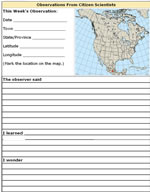What
Were the Monarchs Avoiding?
The people quoted below saw monarchs that seemed to be avoiding something.
The butterflies were traveling in places where the local geography is
dangerous for them. In each example, there was something large that the
monarchs did not want to fly across.
- Find the location of each sighting on the map. (Click the link to see on Google Maps.)
- What is the name of the large geographic feature that the monarchs were avoiding?
For Your Journal: Each week, choose your favorite monarch sighting and record your thoughts in your journal. >>
September
17: Leamington, Ontario (42
N, -83 W)
Here at Point Pelee National Park, we found around 600 monarchs roosting
near the Tip this morning. A strong south wind will keep the monarchs
here until the wind direction changes. (Note: The "Tip" is the
tip of the Point Pelee Peninsula, the southernmost point of Canada.)
- See location of Point Pelee, Ontario on Google Maps.
September
15: Port Stanley, Ontario (43
N, -81 W)
I counted approximately 350 monarchs flying west along cliffs on the north
shore of Lake Erie today from 2-3 pm. I also sighted an afternoon roost
of about 100 monarchs. They were roosting on old Queen Anne's Lace. Not
nectaring, just resting. The area is known as Hawks Cliff, right along
the north shore of Lake Erie, just east of Port Stanley.
- See location of Hawk Cliff, Ontario on Google Maps.
September
15: Whitby, Ontario (44
N, -79 W)
Hundreds of monarchs sighted flying west, hugging Lake Ontario's northern
shoreline. Hundreds were also resting in trees. There was a strong westerly
wind, the aftermath of Ike, which blew through yesterday.
- See location of Whitby, Ontario on Google Maps.
September
15: Freeport, Maine (44
N, -70 W)
We live on 10 acres of farmland on Casco Bay and we have for 7 years watched
the monarchs migrate across our property. Today, 15th of September, 2008,
my 7 year old daughters and I sighted hundreds of monarchs in our 7 acre
field of mostly clover and fallwild aster. The field is on Casco Bay.
We did not attempt to count the butterflies, but it was many hundreds.
When the sun set, they went into the top of the tall oak trees on the
side of our field.
- See location of Casco Bay, Maine on Google Maps.
Can
you find others?
Look for more examples of ways geography affects monarch migration.
- You can find all observations reported this week in the sightings database and on the migration maps.
